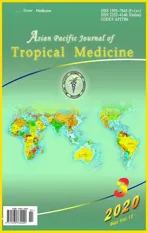Novel coronavirus (2019-nCoV) update: What we know and what is unknown
2020-12-23FolorunsoOludayoFasina
Folorunso Oludayo Fasina
1Emergency Centre for Transboundary Animal Diseases, Food and Agriculture Organization of the United Nations (FAO-ECTAD), Dar es Salaam,14111, United Republic of Tanzania
2Department of Veterinary Tropical Diseases, University of Pretoria, Onderstepoort 0110, South Africa
The year 2020 was welcomed and characterized with a report of pneumonia of unknown etiology, which occurred primarily in Wuhan City of Hubei Province of China. Between 31 December 2019 and 3 January 2020, a total of 44 cases in human was reported to the World Health Organization (WHO) by the Chinese Health Authorities[1]. By 3 February 2020, a total of 17 391 cases have been confirmed globally with 2 838 new cases (China: 17 238;2 831 new cases and 361 deaths; Outside China: 153 with 7 new cases and 1 death from 23 countries)[1]. Wuhan City of Hubei Province has accounted for approximately 64.8% of all cases from China. Globally, the risk of infection and spread remains high. The pathogen causing the infection has been classified as 2019 novel coronavirus (2019-nCoV). Due to a surge in numbers of cases from the third week of January 2020, and after intense consultations and deliberations by the International Health Regulations (2005)Emergency Committee, the WHO, on 30 January 2020 declared the outbreak of 2019-nCoV a Public Health Emergency of International Concern (PHEIC)[2,3]. Since the date of this declaration, global attention has been focused on 2019-nCoV[4,5].
Preliminary clinical features indicated that most of the infected patients were men with underlying diseases (comorbidities)including diabetes, hypertension, cardiovascular disease, chronic obstructive pulmonary disease, malignancy and chronic liver disease[6]. Patient presented with fever, cough, myalgia, sputum production, headache, haemoptysis, diarrhea and dyspnea[6]. Personto-person transmission and familiar association have also been confirmed[7]. To date, a diagnostic kit has been developed for 2019-nCoV[8], and efforts are ongoing to develop other protocols.
Whilst several important aspects of 2019-nCoV epidemiology,virology, mode of transmission, pathogenesis, diagnosis, clinical features, have been defined, there remain many unanswered questions, including source, transmission and epidemic potential.The Wuhan outbreak is a stark reminder of the continuing threat of zoonotic diseases.
Detailed clinical, laboratory and epidemiological findings are available in several studies[3,6,7], and further works are ongoing to solve the several unknown about the virus (more details on the source, epidemiology, virology, mode of transmission, pathogenesis,diagnosis, clinical features and epidemic potential). These information will be needed to solve many unanswered questions.
Specifically, it has been confirmed that many of the patients with ongoing outbreak in humans have linkages with a large seafood and live animal market in Wuhan, Hubei Province[3]. Evidence also suggests that the 2019-nCoV is closely related to coronavirus from bats[9], a strong indication that the virus may have an animal source(with bats acting as the primary source and the animals available in the seafood market serving as intermediate hosts between human and bats). However, while it is known that humans are the terminal hosts for 2019-nCoV, it still needs further investigations whether this is similar to the situation in Severe Acute Respiratory Syndrome coronavirus (SARS-CoV), where masked palm civet is the intermediate host, and MERS-CoV where dromedary camels have been identified as intermediate hosts[9]. The yet-to-be-identified wild animal(s) may be the intermediate host for the ongoing 2019-nCoV. It therefore becomes important to utilize one health approach in the implementation of investigation and control of the ongoing 2019-nCoV.
Recent models have suggested that a lot more cases than those confirmed and reported to the WHO may have occurred[10]. It was also suggested that human-to-human transmissibility is highly likely and the epidemic may spiral out of control without the implementation of effective control measures[11]. In Germany, an asymptomatic contact served as a source of 2019-nCoV transmission to other patients and this has introduced another dimension to the transmission dynamics in the current outbreaks[12]. The health authorities have quarantined several cities in Hubei Province in an unprecedented public health response, yet outbreak continues to be reported in several locations in China, as well as in the Western Pacific, South East Asia, North America, Europe and Middle East where intense import control measures have been implemented. It is important for the infectious disease community globally to draw from the lessons of SARS-CoV, Asian highly pathogenic avian influenza H5N1 (HPAI H5N1), MERS-CoV and other public health emergencies, particularly those that have originated from the South East Asia axis, to combat the current situation in South East Asia and elsewhere. Finally, global efforts continue to target vaccine development, an urgently needed biological that may stem an epidemic. The world will continue to monitor the 2019-nCoV‘zoonotic’ respiratory diseases as progress is made in global health security.
Conflict of interest statement
The author declares that there is no conflict of interest.
杂志排行
Asian Pacific Journal of Tropical Medicine的其它文章
- Dose prediction of lopinavir/ritonavir for 2019-novel coronavirus (2019-nCoV)infection based on mathematic modeling
- Emerging and re-emerging human infectious diseases: A systematic review of the role of wild animals with a focus on public health impact
- Mapping the high burden areas of cholera in Nepal for potential use of oral cholera vaccine: An analysis of data from publications and routine surveillance systems
- Etiologies of tropical acute febrile illness in West Pahang, Malaysia: A prospective observational study
- Blastocystis incidence, spontaneous clearance, persistence and risk factors in a rural community in Thailand: A prospective cohort study
- Molecular isolation and identification of Mycobacterium avium subsp. hominissuis in Didelphis virginiana from Hidalgo, Mexico
